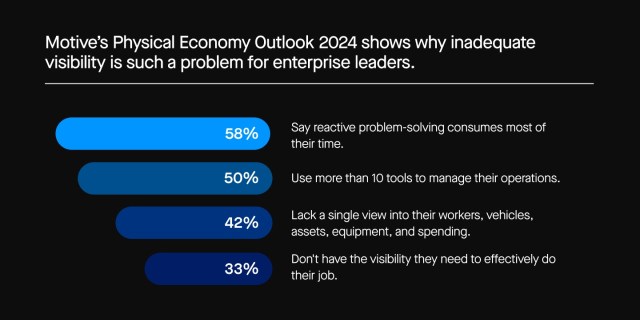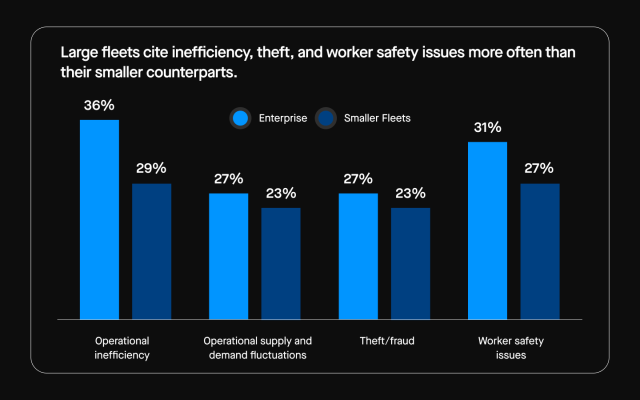Managing a fleet of hundreds or thousands of vehicles is complex. Doing it in the face of rising costs, economic uncertainty, and labor shortages is an invitation for disaster. To mitigate these challenges, enterprise fleets must have a proactive, strategic approach supported by the most advanced technology solutions.
What’s challenging enterprise fleets?
Without complete visibility into on-the-road, on-site and back-office systems, enterprise leaders are unable to effectively track the operators, vehicles, and assets they’re responsible for. A Motive survey of more than 1,000 physical economy leaders found that most physical operations leaders admit they lack the necessary visibility into their fleet to effectively do their job. It’s preventing them from becoming as safe, productive, and profitable as their business requires.
Why visibility is crucial for enterprise fleets
Managing a large commercial fleet is a complex undertaking due to the intricacies and scale involved. Key challenges include coordinating logistics for efficient route optimization, schedule management, and vehicle assignment. Proactive maintenance and timely repairs are crucial to keeping the fleet in optimal condition, demanding meticulous oversight for routine schedules and unexpected breakdowns.
Fuel management, driver management, regulatory compliance, technology integration, and other factors further contribute to the demanding nature of fleet management at a large scale. Addressing operational challenges requires a blend of logistical expertise, advanced technologies, regulatory adherence, and proactive strategies.
In fleet operations, where anything can happen from moment to moment, inadequate visibility is a huge liability. It opens the door to accidents, false claims, fraud, and theft. Some enterprise leaders simply accept this lack of visibility as a necessary evil, as if complete visibility into fleet operations doesn’t exist. But it does exist. And large fleets could be benefiting from it.

Reactivity like this causes chaos and stress in large operations, potentially leading to accidents, inefficiency, and exorbitant costs. Hamstrung by supply and demand fluctuations, theft, and worker safety issues, large fleets struggle from these issues most.

Do you have a visibility problem? Make your own assessment by answering these questions.
Despite these challenges, technological advancements have enterprise leaders feeling optimistic about the year ahead. To make the most of tech opportunities, explore these options.
Do you consolidate the tools in use?
By consolidating tools, enterprises can simplify operations, cut costs, and enhance productivity through streamlined workflows. Moving to a more integrated system can seem daunting, but the benefits of having a cohesive, data-driven view of your entire operation are immense. It’s about making a strategic shift toward efficiency, cost savings, and enhanced decision-making that can propel your fleet management into the future.
Do you analyze data handling processes?
Investigate how data is handled within the organization, focusing on potential silos and manual processes.
- Leveraging integrated data systems can significantly reduce decision-making time and increase operational agility by providing a single dashboard and unified view for critical metrics.
- With real-time visibility into issues as they arise, operators are empowered to take faster routes, cut fuel spend, prevent accidents, and be more productive.
Have you invested in AI?
Implementing AI not only automates routine tasks but also serves as a strategic tool for enhancing decision-making, improving safety measures, and driving significant cost savings. Enterprise leaders agree, with 76% saying they want to use AI to improve visibility across their physical operations. Be aware, however. Not all AI is created equal. It’s critical to ensure that any AI solutions you consider provide accurate, real-time risk detection.
Do you evaluate proactive vs. reactive approaches?
A staggering 58% of enterprise leaders admit that reactive problem-solving consumes most of their time. To avoid inefficiency like this, assess the balance between proactive and reactive approaches.
- Determine the percentage of time spent on reactive problem-solving, especially in comparison to proactive management.
- Adopting analytical tools can transform reactive operations into proactive insights, allowing for preemptive issue resolution and optimization.
Have you conducted a comprehensive visibility assessment?
Eighty percent of enterprise leaders agree that having a single, unified platform to manage their operations would make their jobs easier, and 76% agree that a unified platform would help them anticipate issues before they happen. However, many leaders don’t have one.
- To gain complete visibility and control, evaluate the current state of visibility into your workers, vehicles, assets, equipment, and spending.
- In conducting a structured visibility assessment, be sure to benchmark current operational metrics, identify visibility gaps, and evaluate the integration of AI-driven analytics for full oversight.
- Taking these steps will help you understand the existing visibility landscape, identify areas for improvement, and leverage AI to overcome challenges.
Are your fleet solutions adaptable to meet ever-changing needs?
Enterprise needs are always evolving, so your tech investments should be adaptable.
- Invest in a customized platform to track and manage a diverse fleet of vehicles, from trucks to vans, and adapt to various operational scales.
- During peak delivery periods, a customized platform will scale to ensure real-time tracking and efficient route management for thousands of shipments.
Do your enterprise systems have effortless integration?
Enterprises often operate with established systems for ERP, HR, and more. By integrating an automated platform with an existing ERP system, for example, you can enable seamless data flow, and improve operational visibility and decision-making across the enterprise.
Do you have guaranteed data security and industry compliance?
Data security and compliance are non-negotiable for enterprises. Invest in solutions with robust security measures in place to protect sensitive data and ensure compliance with industry regulations like the FDA’s Electronic Records and Signatures rule.
Do your operations have round-the-clock support?
The complexity of enterprise operations requires dedicated, 24/7 support. Look for a provider that can offer this type of assistance, ensuring that any issues are promptly addressed to maintain continuous operations across all locations.
The AI advantage
Many fleet operators grapple with inefficiencies like route deviations, driver issues, unexpected maintenance, and compliance issues, all of which contribute to visibility gaps and operational setbacks. The pain of not having real-time insights can lead to massively delayed decisions, increased costs, and missed opportunities.
By adopting AI, fleets can transform these pain points into competitive advantages. Real-time tracking and predictive analytics provide immediate, actionable insights, enabling operators to make informed decisions swiftly. This leads to optimized routes, fewer accidents, proactive maintenance, and streamlined compliance processes — turning operational challenges into seamless efficiency and a stronger bottom line.
When you pivot from enduring the common pains of inefficient fleet management to proactively leveraging AI for immediate, positive outcomes, you’ll set the foundation for sustained operational excellence and business growth.
Choose a partner, not just a vendor
To ensure success, large fleets need a platform partner that is scaling technology quickly. Motive is continuously iterating and works with enterprise companies to develop solutions that meet their specific needs, including AI capabilities that deliver real value and ROI. Download our ROI report today to learn how Motive customers are achieving higher ROI and transforming their operations.
For more insight into enterprise challenges and opportunities, and how they’re using AI to their advantage, download Motive’s full Physical Economy Outlook.





